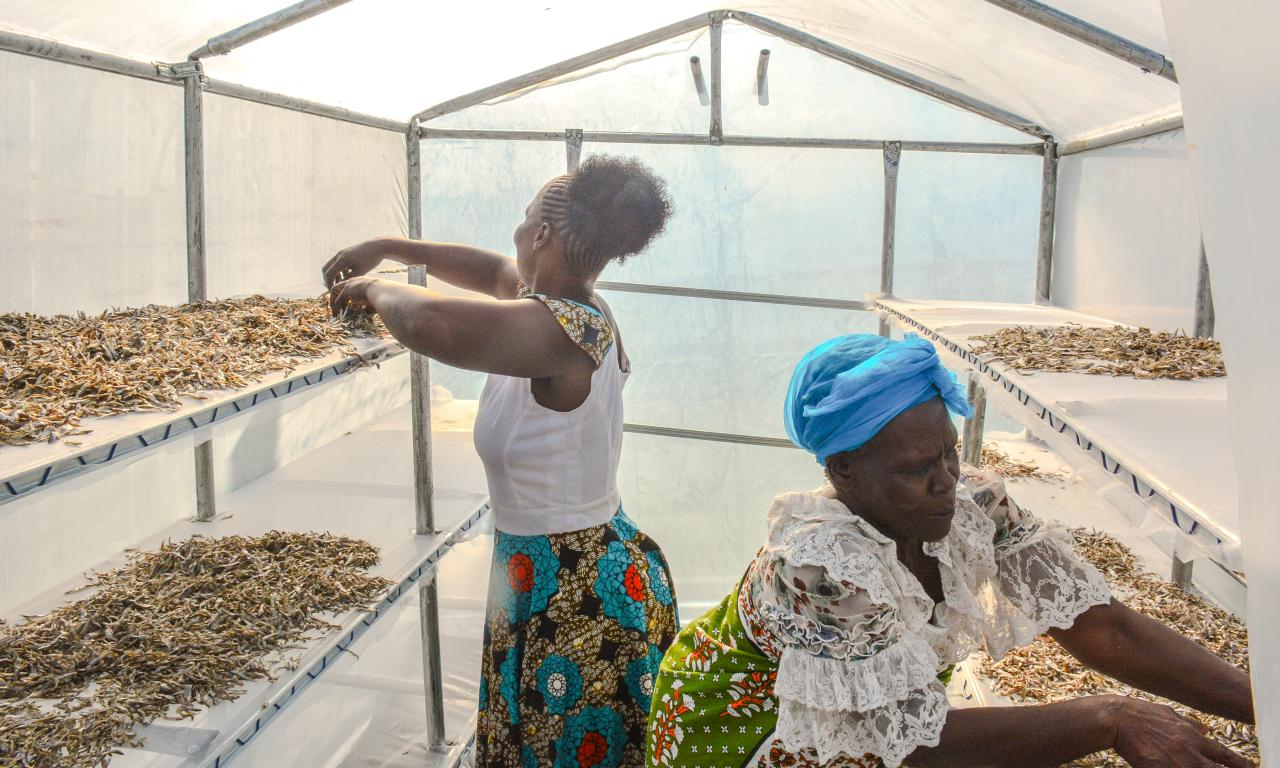
Aquatic foods play a significant role in the diets and nutrition of women, especially women and girls of reproductive age, providing a rich source of affordable protein, vitamins, minerals and healthy fats. These nutrients are particularly important for healthy pregnancies and infant development.
At the same time, women play an equally significant role in SSF and aquaculture. Almost half of the 600 million fish workers are women. They work across the entire fish supply and distribution chain and often assume responsibility for adding value to the catch through drying, smoking and marketing.
In 2023, our teams helped increase scientific understanding of the links between gender, nutrition and livelihoods within aquatic food systems. This generated insights that led to high-impact interventions and resulted in tangible improvements in gender equality.
Building Climate Resilience of Women
Part of our work on reducing postharvest fish losses involved applying a gender lens to understand how climate change was impacting women, men and youths and their livelihoods within the fish value chain.
To do this, we conducted a scoping study that assessed the impact of climate change on the livelihoods of fisher communities, with a strong gender lens in the Lake Victoria Zone region of Kenya, to identify key challenges and needs.
Among our findings was the fact that meteorological data (1981–2022) demonstrated a significant upward trend for minimum and maximum temperatures and rainfall. These changes have resulted in declining fishstocks, destroyed infrastructure, increased conflicts and disease, and reduced incomes, leading to higher poverty levels. The rainfall and extreme temperatures also contributed to postharvest losses because of a lack of fish handling and processing facilities. These losses tend to impact women more than men as they lack access to fish handling facilities and are more involved in small-scale trading.
This insight ultimately led to the delivery of equipment, including solar powered freezers, solar tent driers and smoking kilns. With this equipment, women are able to store and process the fish before it is damaged or lost by the elements, thus improving their opportunities to make a living. Studies indicate up to 60 percent of fish is lost along Kenya’s value chain, the equivalent of feeding more than 21 million people.
Women in the region have since started to use the freezers to generate additional income by charging per kilogram to store surplus fish. Many have used the income to pay for their children school fees, among other benefits.
Understanding and Serving Women’s Dietary Choices
We also made an important breakthrough in understanding fish consumption patterns in India, which helps inform gender- and nutrition-sensitive decision-making in fisheries management.
In a first of its kind study, carried out in collaboration with the Indian Council of Agriculture Research and completed in 2023, we found higher fish consumption than previously reported in India, a country traditionally associated with vegetarian diets.
Analysis of consumption levels between 2005 and 2021 found that India’s fish-eating population increased by a third, the greatest increase of non-vegetarian food after eggs. We also found that men had a higher fish consumption rate (78 percent) than women (65 percent).
This research highlights the need to ensure the responsible management of fisheries and sustainable aquaculture growth to meet current and future demand. But it also identifies opportunities to invest in the fish value chain to benefit women, both in terms of improved nutrition and livelihoods, to close the gender gap.
Understanding the diverse behavior and preferences of fish consumers, including women, throughout India would be the first step toward adopting effective fish production, marketing and policy strategies. A consumer-centric approach to production would help direct investment and innovation toward priority subsectors or species based on demand, ensuring the viability and sustainability of the sector.
Meanwhile, empowering women within aquatic food systems would also support improved nutrition for households and families, including children. For example, mothers committees were among those involved in training sessions on the importance of small fish powder for children as part of a supplementary nutrition program in Assam. As part of the project, more than 3000 children consumed locally produced small fish powder three times per week, while community organizations and women’s groups were trained in the nutritional benefits to help support childhood development. Demand for such fish powder in turn generates income opportunities for women working in fish processing.
Aquatic food systems make vital contributions to the nutrition and livelihoods of women around the world. As we continue to understand these links, we can provide increasingly rigorous scientific recommendations for evidence-based policies and interventions that target gender equality and social inclusion through sustainable fisheries and aquaculture.

